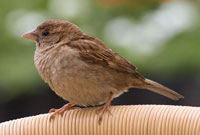Trapping
 Netting or trapping is a good alternative for controlling nuisance birds in areas where there are other bird species. Live trapping methods such as funnel entrance, automatic and triggered traps, nest box traps, decoy traps and mist nets are widely used for house sparrow control songbirds can be released unharmed. When using traps, prebait the area without a trap for one or two weeks by putting out a bait like cracked corn. Then set the traps with the same bait inside. Make the traps more attractive by placing live decoys of the same species inside in a separate compartment so they cannot escape. Provide food and water for the decoy birds.
Netting or trapping is a good alternative for controlling nuisance birds in areas where there are other bird species. Live trapping methods such as funnel entrance, automatic and triggered traps, nest box traps, decoy traps and mist nets are widely used for house sparrow control songbirds can be released unharmed. When using traps, prebait the area without a trap for one or two weeks by putting out a bait like cracked corn. Then set the traps with the same bait inside. Make the traps more attractive by placing live decoys of the same species inside in a separate compartment so they cannot escape. Provide food and water for the decoy birds.
Check the traps several times each day so you can release nontarget birds unharmed and reduce the number of birds that might find a way to escape. Destroy house sparrows, starlings or pigeons caught in the trap in a humane manner. Check with local animal control or wildlife conservation officers for trapping rules. Some cities and towns require special permits.
Laws and Regulations
If exclusion from food or roosts is not possible and trapping or scaring has proven ineffective, chemical control is another alternative. However, it is not always a good choice and often does not provide satisfactory results. Before using chemicals, first determine what kind of bird is causing the problem. House sparrows (sometimes called English sparrows), starlings and pigeons are the most common offenders. Without a permit, chemical controls can be used only on these three species.
Because using chemical controls may result in birds dying in public places, public understanding and support should be secured before they are used. Without it, a public relations problem may arise. Be sure to collect all carcasses and dispose of them properly by burying or burning.
Federal and state laws protect all songbird species except house sparrows, pigeons and starlings. Read and follow all label directions.